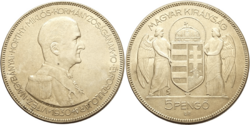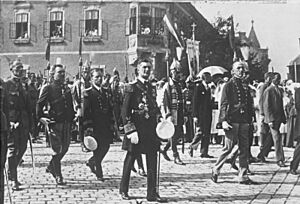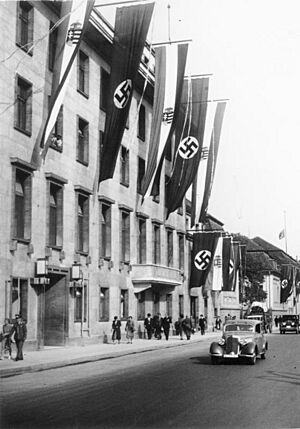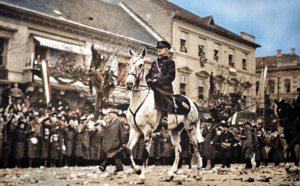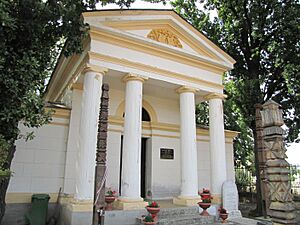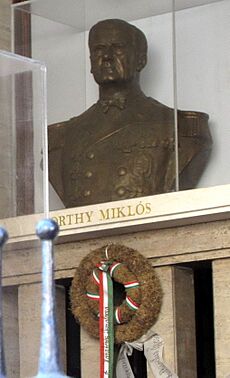Miklós Horthy facts for kids
Quick facts for kids
His Serene Highness Vitéz
Miklós Horthy
de Nagybánya
|
|
|---|---|
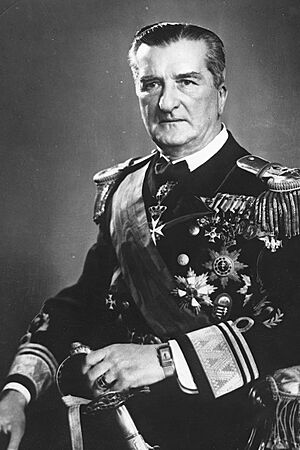
Official portrait, 1941
|
|
| Regent of Hungary | |
| In office 1 March 1920 – 16 October 1944 |
|
| Monarch | Vacant |
| Prime Minister |
See list
Károly Huszár
S. Simonyi-Semadam Pál Teleki István Bethlen Gyula Károlyi Gyula Gömbös Kálmán Darányi Béla Imrédy Pál Teleki F. Keresztes-Fischer (acting) László Bárdossy F. Keresztes-Fischer (acting) Miklós Kállay Döme Sztójay Géza Lakatos |
| Deputy | István Horthy (1942) |
| Preceded by | Károly Huszár (as acting head of state) |
| Succeeded by | Ferenc Szálasi (as Leader of the Nation) |
| Personal details | |
| Born |
Miklós Horthy de Nagybánya
18 June 1868 Kenderes, Hungary, Austria-Hungary |
| Died | 9 February 1957 (aged 88) Estoril, Lisbon, Portugal |
| Spouse |
Magdolna Purgly
(m. 1901) |
| Children | 4, including István and Miklós |
| Parents | István Horthy Paula Halassy |
| Signature |  |
| Military service | |
| Allegiance | |
| Branch/service | |
| Years of service | 1896–1918 |
| Rank | Vice Admiral |
| Commands | Flottenkommandant |
| Battles/wars | World War I |
Miklós Horthy (born June 18, 1868 – died February 9, 1957) was a Hungarian admiral and important leader. He served as the Regent of the Kingdom of Hungary from 1920 to 1944. A regent is someone who rules a country when there is no king or queen. Horthy led Hungary during the time between World War I and World War II, and for most of World War II.
Horthy started his career in the Austro-Hungarian Navy in 1896. By 1918, he had become a rear admiral. He fought in the Battle of the Strait of Otranto during World War I. In the last year of the war, he became the commander of the Navy. After the war, Hungary faced many changes and conflicts. Horthy returned to Budapest with the National Army. Later, the Hungarian parliament asked him to become the regent of the kingdom.
During his time as regent, Horthy's government was known for being very traditional and nationalistic. It also had strong anti-Jewish views. Hungary banned the Communist Party and the Arrow Cross Party. Horthy wanted to get back lands that Hungary had lost after World War I due to the Treaty of Trianon. In the late 1930s, Hungary formed an alliance with Nazi Germany against the Soviet Union. With support from Adolf Hitler, Hungary regained some of its lost territories.
Hungary helped Polish refugees in 1939. In June 1941, Hungary joined the Axis invasion of the Soviet Union. Some historians believe Horthy was not very keen on helping Germany's war efforts or the terrible events of the the Holocaust in Hungary. He also tried to make secret deals with the Allies of World War II. This led Germany to invade and take control of Hungary in March 1944. Before this, many Jewish people in Hungary were killed. After the German occupation, hundreds of thousands more were sent to Auschwitz-Birkenau, where most died.
In October 1944, Horthy announced that Hungary would stop fighting and leave the Axis powers. The Germans then forced him to resign and arrested him. He was taken to Germany. After the war, American troops took him into custody. He later gave evidence for war crimes trials. Horthy then lived the rest of his life in Portugal. He wrote a book about his life called A Life for Hungary. Today, he is seen as a controversial figure in Hungarian history.
Contents
Miklós Horthy was born in Kenderes, Hungary, on June 18, 1868. His family was part of the lower nobility. His father was a member of the Hungarian parliament. Miklós was the fourth of eight children, and they were raised as Protestants.
When he was 14, Horthy joined the Austro-Hungarian Naval Academy. The main language there was German, so Horthy spoke Hungarian with a slight German accent for the rest of his life. He also learned to speak Italian, Croatian, English, and French.
As a young man, Horthy traveled the world. He worked as a diplomat for Austria-Hungary in the Ottoman Empire and other countries. In 1901, he married Magdolna Purgly. They had four children: Magdolna, Paula, István, and Miklós. From 1911 to 1914, he worked as a naval assistant to Emperor Franz Joseph I of Austria, whom he greatly respected.
When World War I began, Horthy commanded a battleship called SMS Habsburg. In 1915, he became known for his bravery while commanding a light cruiser, SMS Novara. He planned an attack in 1917 that led to the Battle of the Strait of Otranto. This was the biggest naval battle of the war in the Adriatic Sea. Even though the Allied fleet was larger, the Austrian forces won the battle. Horthy was wounded during the fight.
After a naval uprising in February 1918, Emperor Charles I of Austria chose Horthy to be the new Commander-in-Chief of the Imperial Fleet. This was a big promotion, as he was chosen over many older commanders. In June, Horthy planned another attack. However, one of his battleships, SMS Szent István, was sunk by Italian torpedo boats. This caused Horthy to cancel the mission. He managed to keep the rest of the fleet safe until the Emperor ordered him to surrender it in October 1918.
After the war, Hungary became a landlocked country, meaning it had no access to the sea. So, Horthy's naval skills were no longer needed. He retired with his family to his home in Kenderes.
Hungary Between the World Wars (1919–1939)
After World War I, Hungary faced two major challenges. First, it lost large parts of its territory to neighboring countries. This was decided by the Allies and confirmed in the Treaty of Trianon in 1920. Hungary lost two-thirds of its land and many Hungarian-speaking people. This was a huge shock for the country.
Second, in March 1919, a Communist leader named Béla Kun took power in Budapest. He created the Hungarian Soviet Republic. His government used violence against its enemies, a period known as the Red Terror.
Anti-communist politicians formed a new government in the city of Szeged. They asked Horthy, who was still seen as a war hero, to lead their army, called the National Army. Horthy agreed.
After the Communist government fell, Romanian forces entered Budapest. In response to the Red Terror, some officers from Horthy's National Army carried out violent acts against Communists, socialists, and Jewish people. This period was known as the White Terror. Horthy tried to stop the worst of these actions, especially those against Jewish people. He later said that such harsh actions were needed to "sweep the country clean."
On November 16, 1919, Horthy entered Budapest with his National Army. He gave a strong speech, accusing the city's people of supporting the Communists. Romanian troops left Hungary in February 1920.
Becoming Regent of Hungary
On March 1, 1920, the Hungarian National Assembly brought back the Kingdom of Hungary. However, the Allied powers would not allow the former king, Charles IV, to return. So, the assembly voted to make Horthy the Regent. He won by a large vote.
Horthy initially refused the role unless he was given more power. The politicians agreed to his demands. He gained the power to appoint and dismiss prime ministers, call and close parliament, and command the army. With these powers, Horthy took his oath of office. He was called His Serene Highness the Regent of the Kingdom of Hungary.
Hungary was legally a kingdom but had no king. Horthy, as head of state, had a lot of influence. He could make sure that laws passed by parliament matched his political ideas.
Seeking to Regain Lost Lands
The first ten years of Horthy's rule focused on making Hungary's economy and political system stable. His main partner in this was Prime Minister István Bethlen. Horthy admired Britain, and British support helped Hungary become stable.
A key goal for Hungary was to get back the lands lost in the Treaty of Trianon. The slogan "Nem, nem soha!" ("No, no never!") became a popular saying expressing Hungarian anger about the treaty.
The Great Depression hurt Hungary's economy. Horthy then appointed Gyula Gömbös as prime minister. Gömbös was a strong anti-Semite and had some fascist ideas. He agreed to Horthy's request to soften his anti-Jewish talk. Gömbös made Hungary's ties with Benito Mussolini's Italy stronger. When Adolf Hitler came to power in Germany in 1933, Gömbös became a close partner.
Gömbös helped the economy by getting trade deals from Germany. This made Germany Hungary's main trading partner and linked Hungary's future closely to Hitler's. Gömbös died in 1936, but he had already set Hungary on a path toward a strong partnership with Germany.
World War II and the Holocaust
An Unsure Alliance
Hungary now had to deal with Adolf Hitler's Germany. Horthy played a big role in guiding Hungary through this difficult time. For Horthy, Hitler seemed like a way to protect Hungary from the Soviet Union. Horthy was very worried about the Communist threat.
Horthy saw Hungary as being stuck between two powerful and dangerous countries. He thought Hitler was the easier one to manage at first. Hitler had a lot of influence over Hungary because Germany was its main trading partner. Hitler also promised to help Hungary regain its lost lands and keep its independence. Horthy's plan was to form careful alliances. How he handled Hitler's demands, especially about military action and the treatment of Jewish people, is a key part of his story.
Horthy's feelings about Hitler were mixed. Hungary wanted to get back its lost territories. The countries that had gained Hungarian land (Czechoslovakia, Yugoslavia, and Romania) were allied with France. So, an alliance with Germany seemed logical. However, Horthy believed that Britain, with its strong navy, would eventually defeat Germany in a war. In 1935, Horthy told Hitler that he should be careful not to start a war with Britain. Horthy was always torn between wanting to regain lost lands with Germany's help and fearing that a war against the world order would lead to defeat.
In August 1938, Horthy visited Germany. Hitler asked Horthy for troops to help invade Czechoslovakia. Horthy said he refused, saying Hungary's land claims should be settled peacefully.
Three months later, after the Munich Agreement, Hungary took back some parts of Czechoslovakia. Horthy rode into these areas with his troops. People were very happy to see him, crying with joy. Even though this was peaceful, it was a result of Hitler's threats of war. Hungary was now involved with the Axis powers. In February 1939, Hungary joined the Anti-Comintern Pact, and in April, it left the League of Nations. American journalists started calling Hungary "the jackal of Europe."
This mix of threats and rewards pushed Hungary closer to being a Nazi-controlled state. In March 1939, Hungary was allowed to take over Carpathian Ruthenia. In August 1940, Hitler helped Hungary again. Hungary took Northern Transylvania from Romania.
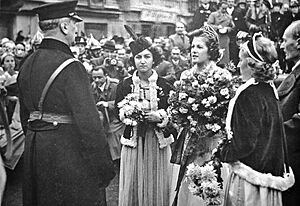
Despite working with the Nazis, Horthy and his government were more "conservative authoritarian" than "fascist." Horthy was against Hungarian fascist groups like the Arrow Cross Party. He even had their leader, Ferenc Szálasi, imprisoned many times.
However, Horthy allowed his government to pass laws that limited the lives of Jewish people in Hungary. The first law in 1938 limited the number of Jewish people in certain jobs to 20 percent. A second law in 1939 reduced it to 5 percent. As a result, 250,000 Hungarian Jews lost their jobs. A "Third Jewish Law" in 1941 banned Jewish people from marrying non-Jewish people.
Horthy's own views on Jewish people are debated. In a letter in 1940, he said he had been anti-Semitic his whole life. He felt that Jewish people had too much control over businesses and professions in Hungary. He believed this needed to be changed over time.
Hungary Enters the War

The Kingdom of Hungary slowly became more involved in World War II. In April 1941, Hungary joined the Axis. Hungary allowed Hitler to send troops through its land to invade Yugoslavia. Hungary also sent its own troops to claim parts of Yugoslavia.
In June 1941, Hungary agreed to Hitler's demands to help in the war. On June 27, Hungary declared war on the Soviet Union. Hungarian troops and supplies were sent just four days after Hitler invaded the Soviet Union.
Later, in January 1943, Hungary's army suffered a huge loss. The Soviet army defeated the Hungarian Second Army at the Don River. About 80,000 Hungarian soldiers died. Many Jewish people and political prisoners in forced-labor units also suffered in this defeat.
German officials blamed Hungary's Jewish people for the army's defeat. Hitler demanded that Horthy punish the 800,000 Jewish people still in Hungary. Horthy's government sent 10,000 Jewish people to labor battalions. But as it became clear the Allies might win the war, Hungary tried to avoid more German demands. The Hungarian government secretly began talking to the Allies, hoping to surrender.
By early 1942, Horthy tried to distance himself from Hitler. He replaced his pro-German prime minister with a more moderate one, Miklós Kállay. Kállay tried to reduce Hungary's ties to Germany, protect refugees, and resist Nazi pressure about Jewish people. He also tried to contact the Allies.
In September 1942, Horthy faced a personal tragedy. His eldest son, István Horthy, who was also the Deputy Regent, died in a plane crash.
Before the German occupation of Hungary, about 63,000 Jewish people in Hungary had already died. Horthy learned about the terrible events at Auschwitz in 1944. A friend told him the truth about the deportations. Horthy's government passed a law against deportations on June 26.
German Occupation and Horthy's Arrest
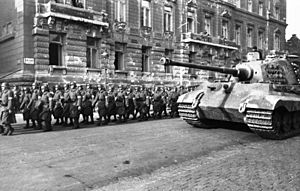
By 1944, Germany was losing the war, and the Red Army was nearing Hungary. Horthy feared the Soviets would take over. He tried to make peace with the Allies. He even promised to surrender to them when they reached Hungary. Hitler, angry, called Horthy to a meeting. He pressured Horthy to help more in the war and to send more of Hungary's Jewish people to their deaths. Horthy allowed the deportation of 100,000 Jewish people but refused to do more.
The meeting was a trick. As Horthy returned home on March 19, the German army invaded and occupied Hungary. Horthy was told he could stay in power only if he fired Kállay and appointed a new government that would fully cooperate with Hitler. Horthy agreed and appointed General Döme Sztójay as prime minister. Sztójay's government then actively helped in the Holocaust.
The new Hungarian government forced 300,000 Jewish people to be sent to Germany. On April 14, the deportation of Hungarian Jews to Auschwitz began. About 12,000 to 14,000 people were sent each day until July 24.
When Horthy learned about the deportations, he wrote a letter to the prime minister. He said that the way Jewish affairs were being handled was "inhuman, stupid and unworthy of the Hungarian character." He demanded that certain officials involved in the deportations be removed.
World leaders, including Pope Pius XII and President Franklin D. Roosevelt, asked Horthy to stop the deportations. Roosevelt even threatened military action. On July 7, Horthy ordered the deportations to stop. By then, 437,000 Jewish people had been sent to Auschwitz, where most died. It is believed that one out of every three people killed at Auschwitz was a Hungarian Jew deported between May and July 1944.
There is still debate about how much Horthy knew about the fate of the Jewish people and what he could have done. Some historians believe he thought they were being sent to labor camps and would return after the war. Horthy himself wrote that he only learned the "horrible truth about the extermination camps" in August.
In August 1944, Romania left the Axis and turned against Germany. This showed that Germany was losing the war. Horthy tried to regain control in Budapest. He removed Sztójay and other pro-Nazi ministers. He stopped the mass deportations of Jewish people and ordered the police to use force if the Germans tried to restart them.
Horthy also tried to make peace with the Allies, especially the Red Army. He believed the Soviets were the lesser evil compared to the Nazis. On October 15, 1944, Horthy announced that Hungary had signed a ceasefire with the Soviet Union.
The Nazis had expected this. On October 15, Hitler launched Operation Panzerfaust. German commandos, led by Otto Skorzeny, went to Budapest to remove Horthy from power. Horthy's son, Miklós Horthy, Jr., was kidnapped by Skorzeny's troops and taken to Germany as a hostage. The Germans then quickly took over Castle Hill with little fighting.
Horthy was captured and told that if he didn't cancel the ceasefire and resign, his son would be killed. The fascist Arrow Cross Party quickly took over Budapest. To save his son, Horthy signed a document officially resigning and naming Ferenc Szálasi, the Arrow Cross leader, as the new head of state and prime minister. Horthy later said that his signature was forced and not legal.
Horthy was taken to a castle in Bavaria, Germany, where he was held under house arrest but lived comfortably. The Arrow Cross leadership then took control of Hungary's army and continued the persecution of Jewish people. Between November 1944 and January 1945, Arrow Cross death squads killed thousands of Jewish people. Out of 825,000 Jewish people in Hungary before the war, only 260,000 survived.
By December 1944, Soviet forces were attacking Budapest. The city surrendered in February. Horthy remained under house arrest until the war in Europe ended. On May 1, 1945, American troops freed him.
Life in Exile
After his arrest, Horthy was held in different places. In September 1945, he arrived at a prison in Nuremberg, Germany. He was asked to provide evidence for the Nuremberg Trials, which were trials for Nazi leaders. He was interviewed many times but did not testify in person. In Nuremberg, he was reunited with his son, Miklós Jr.
Horthy believed that the United States had arranged his arrest to protect him from the Russians. He was not charged with war crimes.
On December 17, 1945, Horthy was released from prison. He joined his family in Weilheim, Germany. They lived there for four years, supported by American diplomats and Pope Pius XII.
In March 1948, Horthy testified at another Nuremberg trial against Edmund Veesenmayer, the Nazi official who controlled Hungary during the deportations to Auschwitz.
Horthy could not return to Hungary because it was now under a Soviet-backed Communist government. In 1950, Horthy and his family moved to Estoril, Portugal. They were supported by wealthy Hungarians and even some Hungarian Jewish families.
In exile, Horthy wrote his memoirs, Ein Leben für Ungarn (A Life for Hungary). In his book, he said he had always mistrusted Hitler and tried to do what was best for Hungary. He also wrote about how Hungary had been treated unfairly by other countries after World War I. Horthy was one of the few Axis leaders who survived the war and wrote about his experiences.
Horthy always disliked communism. In his memoirs, he blamed Hungary's alliance with the Axis on the threat from the Soviet Union. He died in 1957 in Estoril, Portugal. He was first buried in Lisbon. In his will, Horthy asked that his body not be returned to Hungary until the last Russian soldier had left. His family respected this wish. In 1993, two years after Soviet troops left Hungary, Horthy's body was returned to his hometown of Kenderes and reburied there.
Legacy
The time when Horthy's government ruled Hungary is known as the "Horthy age" or "Horthy system." His legacy is still a very debated topic in Hungary today. It is closely linked to the Treaty of Trianon and the Holocaust.
Some people believe Horthy was a strong, traditional leader who was not against democracy. They think he only allied with Hitler to get back lands Hungary lost after World War I. They also argue that he was unwilling to deport Hungarian Jewish people.
Others see Horthy's alliance with Germany as a bad decision. They point to the anti-Jewish laws passed under his rule, which were some of the earliest in Europe (starting in 1920). They see these laws as a sign of his anti-Semitism and a step towards Hungary's involvement in the Holocaust.
Images for kids
-
The damaged SMS Novara after the Battle of Otranto
-
Horthy, seriously wounded, commanded the fleet at the Battle of the Strait of Otranto until falling unconscious
-
With the Treaty of Trianon, the Kingdom of Hungary lost 72% of its territory (including Croatia) and 3.3 million people of Hungarian ethnicity.
-
Admiral Miklós Horthy enters Budapest at the head of the National Army, 16 November 1919. He is greeted by city officials in front of the Gellért Hotel. The Romanian army retreated from Budapest on 14 November, leaving Horthy to enter the city, where in a fiery speech he accused the capital's citizens of betraying Hungary by supporting Bolshevism
-
Miklós Horthy with King Victor Emmanuel III of Italy in Rome on 25 November 1936, during a military parade in Via dell'Impero
-
Horthy during the Hungarians' entry into Komárom (present-day Komárno), following the First Vienna Award, November 1938
See also
 In Spanish: Miklós Horthy para niños
In Spanish: Miklós Horthy para niños
- El ángel de Budapest
- History of Hungary
- Mediterranean naval engagements during World War I


